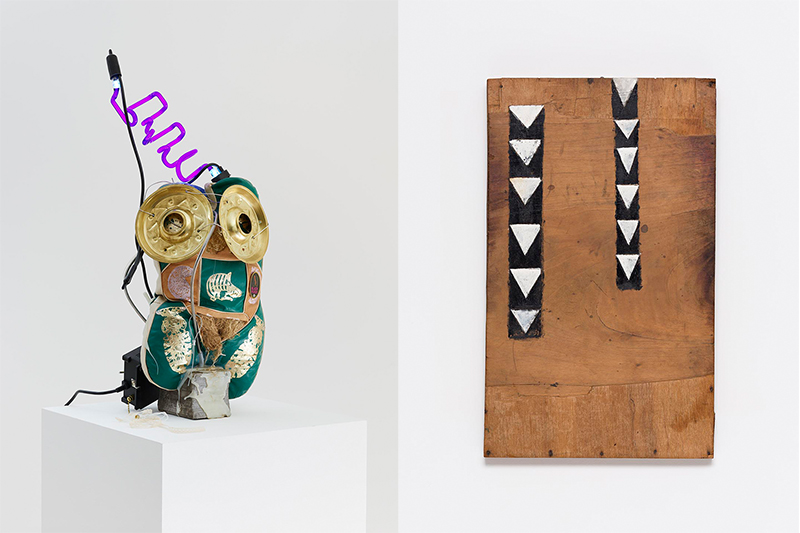ART CITIES:London-Markers
 The group exhibition “Markers” celebrates the humble punctuation mark. Like the exclamation mark, and the multivalent and shifting sentiments it has come to represent, this show (encompass artworks that “evoke diffuse and even contradictory meanings within a single visual gesture”. The exhibition includes works by both emerging and established artists that elicit such oppositional emotions at once, frequently as a means of negotiating the polarities and vagaries of contemporary society.
The group exhibition “Markers” celebrates the humble punctuation mark. Like the exclamation mark, and the multivalent and shifting sentiments it has come to represent, this show (encompass artworks that “evoke diffuse and even contradictory meanings within a single visual gesture”. The exhibition includes works by both emerging and established artists that elicit such oppositional emotions at once, frequently as a means of negotiating the polarities and vagaries of contemporary society.
By Dimitris Lempesis
Photo: David Zwirner Gallery Archive
In “Markers” are on presentation works by: Matt Connors, Michael Dean, Marlene Dumas, Goutam Ghosh, Josh Kline, Gillian Lowndes, John Outterbridge, Gerhard Richter, Celso Renato, Jason Rhoades, Prem Sahib, and Pádraig Timoney. Graphically the exclamation mark is represented as a full stop point with a vertical line above. One theory of its origin is that it is derived from a Latin exclamation of joy (io). The modern graphical representation is believed to have been born in the Middle Ages. Medieval copyists wrote the Latin word io at the end of a sentence to indicate joy. The word io meant “hurray”. Over time, the i moved above the o, and the o became smaller, becoming a point. Over the centuries, its connotations have become corrupted, it is simultaneously warning and exaltation, interjection, and admonition. Mirroring this semiotic shift, in particular, is the transition from analogue to digital culture, and the shorthand and indeterminate mode of expression it has engendered. Today the world is full of markers, whether commercial symbols such as the Coca Cola logo or, in writing and modern digital media, the exclamation mark, the question mark and the phrase “lol”. The exhibition includes works by both emerging and established artists that elicit such oppositional emotions at once, frequently as a means of negotiating the polarities and vagaries of contemporary society. Mirroring this semiotic shift in particular is the transition from analogue to digital culture, and the shorthand and indeterminate mode of expression it has engendered. Amongst the works on view is John Outterbridge’s “Rag Factory IV” (2017), an evocative arrangement of colorful, found rags tied together and suspended from the ceiling like a curtain. Indicative of artist’s innovative approach to materials since his earliest, assemblage-style works of the ‘60s, the installation has both autobiographical and social resonances. Incorporating nonconventional and readymade objects, the ceramic sculptures by Gillian Lowndes appear at once otherworldly and domestic, and reflect the British artist’s pioneering experimentations with her medium. Matt Connors explores the intersection between mimesis and abstraction in the large-scale painting “A New Illusion” (2017), whose visual vocabulary evokes modernist processes, but ultimately rejects categorization. The diagrammatic works by artist Goutam Ghosh are inspired by the unspecified common ground occupied by religion, science, and magic. Also on view is a canvas by Marlene Dumas, “The White Disease” (1985), which offers a punctuating reflection on identity and ethnicity. Other artists building meaning and symbolism into their work include Josh Kline with “Sighs of the Times”, Padraig Timoney with “Bus Stop (Glenshane)” and Michael Dean with “Shore Shake” and Prem Sabib’s drinking fountain having a double meaning about our sophisticated cultures fussing over the quality of drinking water and its mineral content while many people across the world do not have access to the most basic of clean water.
Info: David Zwirner Gallery, 24 Grafton Street, London, Duration: 24/11-20/12/17, Days & Hours: Tue-Fri 10:00-18:00, Sat 10:00-16:00, www.davidzwirner.com








